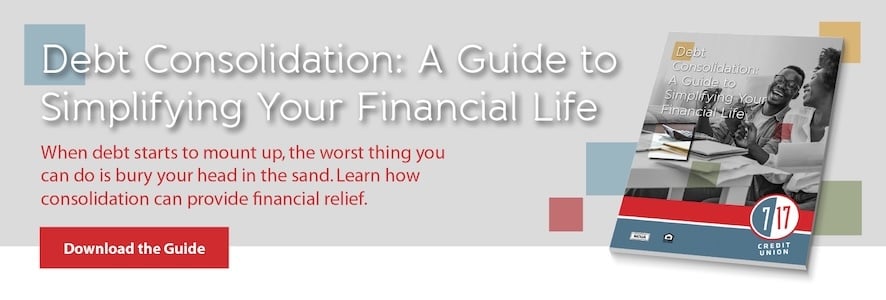- 7 17 Staff
Debt Consolidation: Learn How To Do It The Right Way With Our Calculator

Having debt isn’t always a bad thing. Mortgages and car loans are valuable tools to help you afford larger purchases. However, there’s a certain point where the debt can get out of hand and jeopardize your financial wellness. But there are steps you can take to address your debts and rebuild your finances.
Debt consolidation is a solid step to address your debts while simplifying your payments, putting you on the right path toward financial wellness. Let’s take a look at how debt consolidation works and what it can mean for your future.
What is debt consolidation?
Debt consolidation reorganizes your debt into a single payment so you can pay off your debts faster. For example, instead of paying multiple debt balances with high interest rates, you’ll be focusing on making one payment with one due date and a lower interest rate.
When is debt consolidation a bad idea?
If you can pay off your debts in less than a year, consolidation may not be worth it. The amount you would save would be negligible, so it’s better to focus on eliminating one debt at a time by putting extra money toward that payment.
If the terms of the consolidation method aren’t better than your current loan or credit terms, it may not be a good idea to pursue consolidation. For example, if your consolidation interest rate is higher, is variable instead of your current fixed rates or has a longer repayment period, consolidating may not be the best decision.
What are some important things to know about debt consolidation?
Consolidating doesn’t erase your debts overnight. Additionally, if you’re consolidating credit card debts, avoid using the credit cards after consolidating because it could put you in a worse position. If you need to keep your credit cards active, only put a small purchase on them once every three months and then immediately pay the balance off.
How does debt consolidation work, and how do you consolidate your debts the right way?
First, you’ll likely need good credit to qualify for debt consolidation. There are a number of steps you can take to improve a low credit score if you are thinking about consolidation. These steps include making payments on time, limiting new accounts and monitoring your credit card usage.
There are a few steps you need to take to consolidate your debt the right way:
- Determine what you owe. Add up the amount of the debts you want to consolidate and make a note of what the interest rates are.
- Calculate your interest rates. Determine your average interest rate to figure out the rate your consolidation method should be lower than.
- Determine what you can afford. Add up all of your necessary expenses, such as your rent or mortgage, transportation costs, food and utilities to have an idea of what you can afford for a consolidated payment.
- Decide what consolidation method is best for you. There are three primary methods to consolidate debts: balance transfer credit cards, consolidation loans and a home equity line of credit (HELOC).
Tip: A debt consolidation calculator is an easy-to-use tool to determine what your current debts look like and help you find the ideal consolidation option that fits both your needs and budget.
What are the main debt consolidation methods?
There are three methods to consolidate your debt, and each one has its own advantages and disadvantages for applicants. It’s essential to do research and determine the best method that works for your needs.
1. Balance Transfer Credit Card
Look for a 0% interest credit card that you can transfer all of your balances to and pay off within the 0% promotional period, which is generally between 12-18 months. However, not all credit card balances can be transferred. For example, a balance can’t be transferred between accounts at the same credit card company.
2. Consolidation Loan
Borrow the total amount of all of your debts to pay off those debts to each lender or credit card company, then make payments on the consolidation loan. Ideally, you want to make sure you have a fixed rate instead of a variable rate loan due to current market conditions.
3. HELOC
If you own a home, you can use the equity you’ve built in your home to get a HELOC, which can offer a low-interest and flexible rate consolidation option. With a HELOC, you essentially open your own line of credit based on the amount of equity you have in your home. The home equity line of credit can then be used for various purposes, including debt consolidation.
It’s important to note that while you can use a 401(k) loan to borrow against your retirement savings and pay off your debts, this type of loan carries numerous risks. Your retirement savings will take a significant hit, and you’ll also have tax penalties, making this type of loan a high-risk, low-reward option.
Ready to improve your financial wellness?
Debt consolidation is a solid step toward improving your financial wellness. One of the essential steps in the path to consolidating your debts is to determine what your debts are and what you can afford. Check out our debt consolidation calculator to determine what consolidation option best fits your needs.
